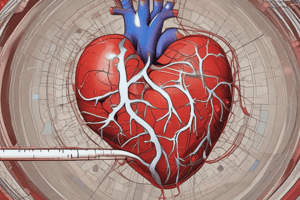Podcast
Questions and Answers
What is classified as hypertensive emergency in terms of blood pressure and organ dysfunction?
What is classified as hypertensive emergency in terms of blood pressure and organ dysfunction?
Hypertensive emergency is defined as blood pressure exceeding 180/120 mmHg along with evidence of organ dysfunction.
List at least three early symptoms of hypertension.
List at least three early symptoms of hypertension.
Early symptoms of hypertension include headache, blurred vision, and dizziness.
What are two complications associated with persistent hypertension?
What are two complications associated with persistent hypertension?
Two complications of persistent hypertension are stroke and ventricular hypertrophy.
What lifestyle changes can be recommended to manage hypertension?
What lifestyle changes can be recommended to manage hypertension?
Signup and view all the answers
What oral manifestation might a dental professional observe in a patient taking antihypertensive medications?
What oral manifestation might a dental professional observe in a patient taking antihypertensive medications?
Signup and view all the answers
What is the threshold for high blood pressure that indicates hypertension in a dental emergency?
What is the threshold for high blood pressure that indicates hypertension in a dental emergency?
Signup and view all the answers
What protocol should be followed to manage a patient with high blood pressure during a dental procedure?
What protocol should be followed to manage a patient with high blood pressure during a dental procedure?
Signup and view all the answers
What are the potential risks associated with the use of epinephrine in local anesthesia for patients with hypertension?
What are the potential risks associated with the use of epinephrine in local anesthesia for patients with hypertension?
Signup and view all the answers
How do NSAIDs affect the efficacy of antihypertensive medications?
How do NSAIDs affect the efficacy of antihypertensive medications?
Signup and view all the answers
What condition results from irreversible myocardial damage due to loss of blood supply?
What condition results from irreversible myocardial damage due to loss of blood supply?
Signup and view all the answers
Study Notes
Hypertension
- Hypertension is persistently elevated blood pressure, specifically systolic blood pressure above 140 mmHg or diastolic blood pressure above 90 mmHg.
- The 2020 American Heart Association guidelines classify hypertension based on office blood pressure measurements.
- High-normal blood pressure (BP) individuals might benefit from lifestyle interventions. Pharmacological treatment may be necessary if compelling indications exist.
- Grade 1 and Grade 2 hypertension individuals should receive pharmacological treatment.
General Manifestations of Hypertension
- Hypertension can remain asymptomatic for years.
- Early symptoms may include headache, blurred vision, tinnitus, dizziness, and fatigue.
Hypertension Complications
- Ventricular hypertrophy
- Stroke
- Arteriosclerosis
- Retinal damage
- Renal failure
Hypertensive Emergency
- Blood pressure exceeding 180/120 mmHg + evidence of organ dysfunction
- Possible symptoms such as intracerebral hemorrhage, unstable angina pectoris, acute myocardial infarction, or heart failure.
- Clinical picture may include chest pain, dyspnea, changes in mental status, visual disturbance, or neurologic deficit.
Hypertension Management
- Lifestyle changes such as weight loss, a low-salt diet, smoking cessation, and alcohol avoidance.
- Antihypertensive medications including diuretics, beta blockers, calcium channel blockers, angiotensin-converting enzyme (ACE) inhibitors, and vasodilators.
Oral Manifestations of Hypertension
- Facial palsy
- Side effects of antihypertensives, such as xerostomia (dry mouth) and salivary gland swelling
- Other potential oral complications like lichenoid reaction, erythema multiforme, angioedema.
Dental Management of Hypertension Patients
- During the initial dental visit, dentists should identify undiagnosed hypertensive patients through detailed history and routine blood pressure measurement.
- Delay or refer dental treatment in cases of undiagnosed patients, uncontrolled blood pressure above baseline values (systolic above 180 mmHg or diastolic above 100 mmHg).
- Pharmacological management of emergency dental conditions until the patient is controlled.
- Stress-reduction protocol to avoid endogenous adrenaline release and greater blood pressure rise.
- Avoid sudden changes in chair position to prevent drug-induced orthostatic hypotension.
- Bleeding is not usually caused by hypertension but by anticoagulants used by hypertensive patients.
- Epinephrine-containing local anesthetics can be used carefully to delay systemic absorption and increase the duration of anesthesia.
Drug Interactions
- Prolonged use of nonsteroidal anti-inflammatory drugs (NSAIDs) can reduce the efficacy of antihypertensive medications.
- Erythromycin and clarithromycin increase the hypotensive action of calcium channel blockers.
Ischemic Heart Disease
- Persistent reduction in blood supply and oxygen supply to the heart through the coronary arteries, caused by thrombus obstruction or arterial wall thickening (atherosclerosis).
- Depending on the duration and extent of ischemia, the heart may experience angina pectoris or myocardial infarction (MI).
- Angina pectoris: Temporary low oxygen supply to a part of the heart muscle, often causing chest pain.
- Myocardial infarction (MI): Necrosis of a part of the heart muscle due to permanent loss of blood and oxygen supply.
Chest Pain
- Stable angina, unstable angina, and myocardial infarction can all manifest as chest pain with varying characteristics and causes.
Emergency Management
- A patient experiencing chest pain during dental treatment must halt procedures, place the patient upright, ensure an open airway and adequate breathing and circulation, administer nitroglycerin sublingually, provide oxygen, and constantly monitor vital signs.
- Immediate emergency interventions like calling for an ambulance, oxygen administration, aspirin usage, and initiating basic life support (CPR), or using an AED should be considered if there are signs of cardiac arrest.
- Pain relief within five minutes is expected. Pain persisting longer, related to nausea, vomiting, syncope, or hypertension, strongly suggests a myocardial infarction (MI) requiring immediate medical attention.
Studying That Suits You
Use AI to generate personalized quizzes and flashcards to suit your learning preferences.
Related Documents
Description
Explore key concepts related to hypertension, including its definitions, classifications, and potential complications. This quiz will help you understand the general manifestations, necessary treatments, and the critical aspects of hypertensive emergencies.




